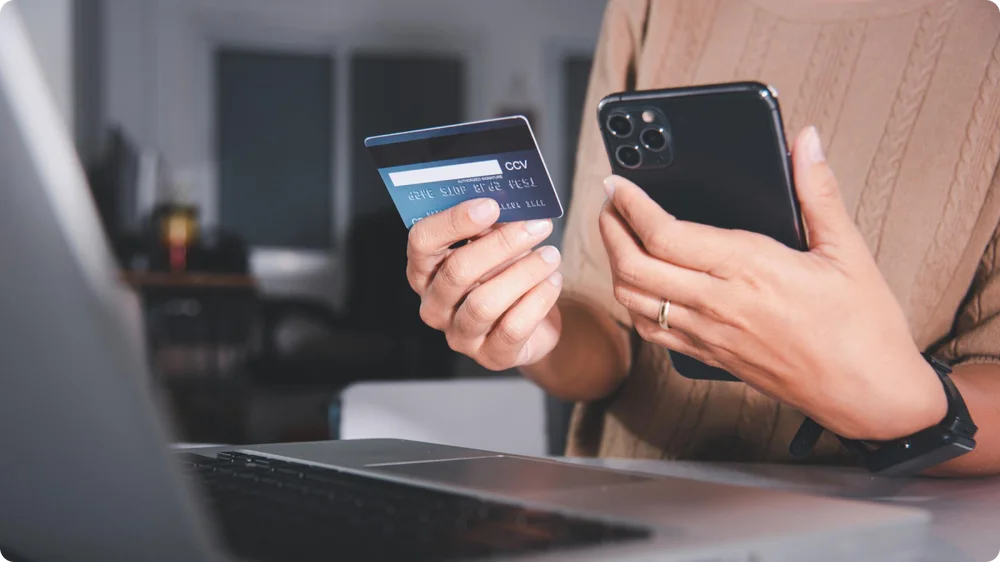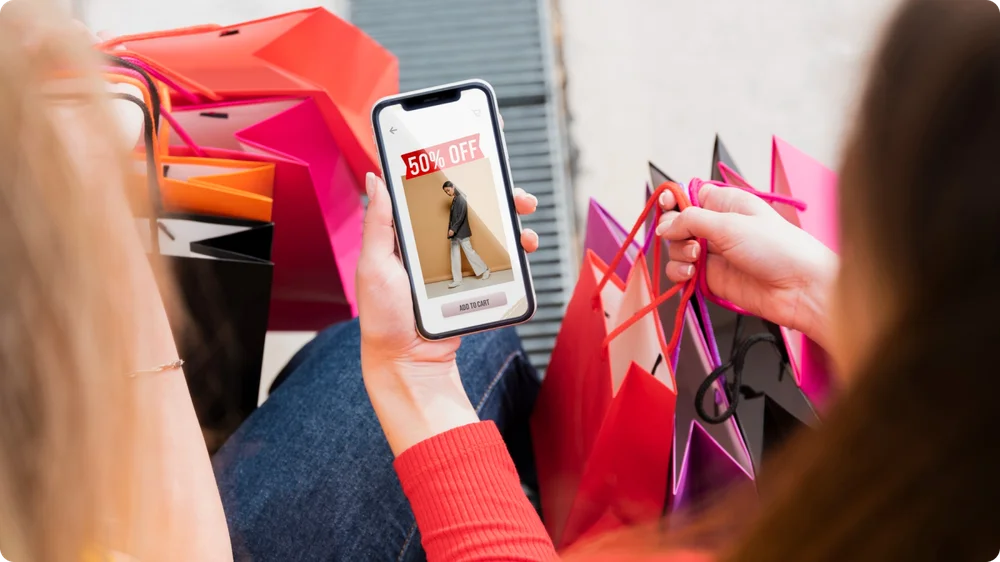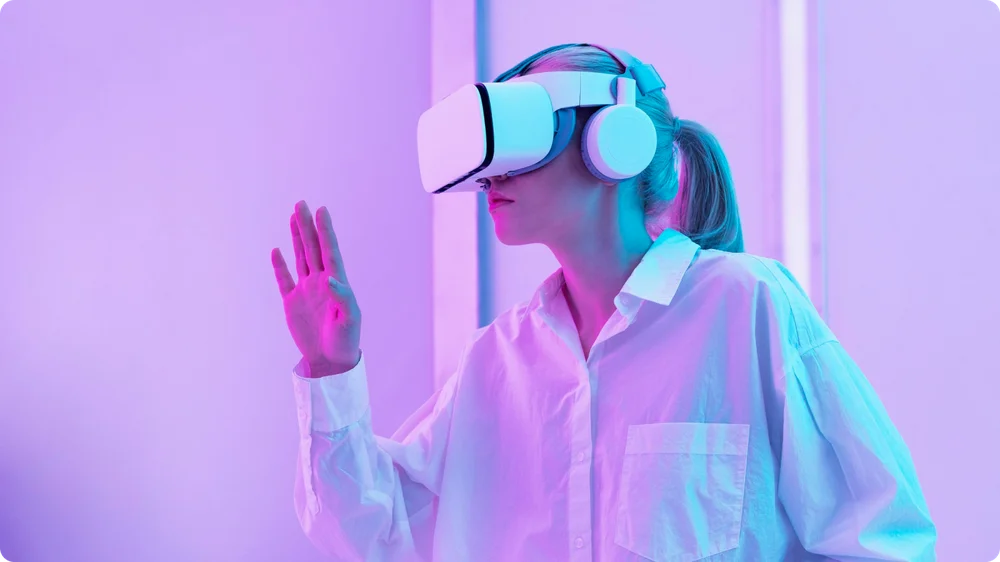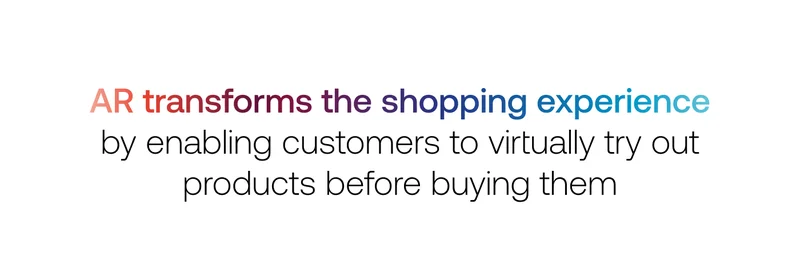
In the fast-evolving e-commerce landscape, mobile commerce stands out as a powerhouse with tremendous potential. Data by Gemius reveal that a staggering 79% of Polish users prefer smartphones when it comes to shopping online, and this figure escalates to an impressive 93% within the youngest demographic. At the same time, 69% of online shoppers complete transactions on laptops, and only 38% buy on desktops.
In the first article from our mobile commerce series, I explored the essence of m-commerce and its potential to turn interactions into transactions. Now it’s time to dive into the factors contributing to the expansion of m-commerce, both on a global scale and in Poland.
From evolving consumer behaviors to emerging technological trends, the realm of mobile shopping is undergoing a revolution, and comprehending the factors behind it is crucial for businesses that want to stay ahead.
The mobile commerce market is rapidly growing and according to GlobeNews Wire is projected to reach USD 3.901 billion by the end of 2026. Moreover, the percentage of Polish internet users engaging in online shopping has nearly doubled over the past decade, climbing from 45% to an impressive 87% (source: Dekada polskiego e-commerce, Izba Gospodarki Elektronicznej).

With the advancements in technology, consumers now have constant access to the virtual world and the offerings of their favorite brands. No matter if we have time off or head to work or school, we explore products in an app or scroll through social media. There, we discover personalized ads that, upon a click, seamlessly transport us to the brand's app or website. All this, combined with quick mobile payments, significantly enhances the shopping experience, making it more frictionless than ever.
So, what are the key factors driving the growth of mobile commerce in Poland and globally?
Year after year, an increasing number of people are adopting smartphones, naturally leading to a surge in the popularity of mobile shopping. DataReportal reveals that in 2023, an impressive 97% of Poles owned a smartphone – this represents a 0.2% year-on-year growth, illustrating a consistent and gradual upward trend in smartphone adoption.
Mobile screen time is also on the rise – we dedicate an average of 5 hours a day to our smartphones and, according to our report, Młodzi vs Mobile, 87% of young consumers aged 15-20 spend anywhere from 2 to 10 hours daily using their phones, with 10% unable to imagine even an hour without them.

The expansion of internet infrastructure, including 4G and 5G networks, enables fast and stable connections, crucial for mobile shopping. According to Deloitte, every other Polish smartphone user possesses a 5G-enabled device, allowing for quicker data transmission when compared to earlier-generation networks.
The latest information from operators indicates that 5G coverage spans between 15 and 20 million Poles, depending on the network (source: Spacetronik). However, it's not just the speed of data transmission that influences the development of mobile commerce.
88% of mobile shoppers prefer using mobile apps over websites, let alone traditional brick-and-mortar stores (source: Clutch).
According to Insider Intelligence's analysis, the share of m-commerce in total retail trade is projected to reach 8.7% by 2026. One of the main drivers behind the growth of this market is the rise of mobile applications. The convenience, personalization, speed, and secure transactions, coupled with easy access to promotions, make shopping through apps efficient. It's no surprise that retailers build their digital products to optimize and personalize shopping experiences.
Well-designed apps not only provide a chance to gain a competitive edge but also serve as a goldmine of information. By capturing key behavioral data about customers, including their preferences, shopping times, and locations, apps facilitate hyper-personalization and allow retailers to take bolder actions in predicting buyers’ needs and tailoring offerings accordingly. This aspect is crucial, as 76% of shoppers feel frustrated if their interaction with a brand is not personalized (source: McKinsey).

In 2023, 94.6% of all card transactions in Poland were non-cash, with contactless cards constituting 96.2% of all payment cards (source: Narodowy Bank Polski). Available contactless payment methods include cards (debit, credit, prepaid), NFC-enabled devices (smartphones, smartwatches), and contactless stickers applied to devices.
In Poland, quick payments are also facilitated by solutions like BLIK. In the first half of 2023, the number of such payments at Poczta Polska increased by 90% compared to the first half of 2022, both with couriers and in post offices. What’s more, the Narodowy Bank Polski estimated that in 2019 BLIK transactions surpassed those made with payment cards. What sets it apart? The possibility to pay quickly, easily, and securely – a trio that contemporary consumers value the most.
Geolocation technology, which harnesses GPS, cellular networks, or Wi-Fi, plays a pivotal role in driving the expansion of mobile commerce. The capability to ascertain a user's location empowers businesses to deliver customized and localized shopping experiences. This may involve providing information about nearby promotions or product availability, thereby enhancing user convenience and granting buyers access to desired products at the opportune moment.
The synergy of analyzing user preferences and location data enables businesses to deploy targeted promotions and discounts, significantly heightening the prospects of successful conversions.

Traditionally, social media platforms heavily relied on advertising revenues, but there has been a notable shift towards a consumer-centric income model. This transformation is a response to changing user behaviors and the dynamic nature of the competitive digital landscape. The trend of social shopping also mirrors the growing expectation for brands to be present across diverse channels – offline, online, mobile, and on social media. A noteworthy 61% of shoppers claim to make purchases from the same brands in multiple places (source: Izba Gospodarki Elektronicznej).
Within this changing landscape, social media has ushered in an innovative marketing approach by capitalizing on influencers and content creators. Studies by the Pew Research Center reveal that a considerable number of social media users, particularly in younger demographic groups, follow influencers and base their purchasing decisions on their recommendations. Our report, Młodzi vs Mobile, aligns with this trend, indicating that 80% of young Poles (aged 15-20) state that they occasionally buy products recommended on social media, with one-fifth of them doing so frequently.
Faced with increasingly sophisticated cyber threats, businesses are adopting more and more advanced solutions to safeguard customers' personal and financial data. The implementation of encryption protocols, like SSL, ensures secure connections between users and e-commerce platforms, shielding sensitive information during transmission. To add extra layers of security, many players introduce two-factor authentication and biometric methods, such as fingerprint scanning or facial recognition. Companies are also investing in fraud monitoring technologies, utilizing artificial intelligence and machine learning to detect irregular transaction patterns.
At this point, it’s also worth mentioning the rising popularity of digital wallets like Apple Pay or Google Pay that play a role in securing transactions by employing tokenization. This process replaces actual payment data with unique codes, offering an additional layer of protection. The ongoing enhancement of online shopping security not only reinforces consumer trust but also serves as a significant motivator for the widespread adoption of m-commerce.
In 2024, non-responsive digital products seem to be a relic of the past. Users expect that websites and applications will automatically adapt to their device's screen.
According to the Baymard Institute, 14% of potential buyers leave shopping carts behind when a website has errors. This shows that responsive design isn't just for aesthetics; it's crucial for effectiveness. Pages that seamlessly adjust to various devices not only elevate the shopping experience, making it seamless and efficient but also boost the chances of successful transactions.

Changing consumer habits reflect the evolution of society and are strongly linked to generational shifts – the youngest consumers don’t remember a world without technology. They naturally gravitate towards mobile shopping, and smartphones are their go-to for managing daily life. Serving as alarm clocks, communication tools, and sources of entertainment, these devices also play a pivotal role in making purchases. Young customers can’t imagine online shopping without the convenience, intuitiveness, and efficiency guaranteed by mobile commerce.
In line with this trend, we can observe an emerging practice – one-click ordering, which enables customers to quickly complete purchases without the need to repeatedly enter payment and delivery information. Amazon, a pioneer in this area, points out that allowing customers to smoothly navigate the checkout process and instantly finalize their purchases is instrumental in boosting overall sales figures.
The advancement of Augmented Reality (AR) technology opens new perspectives for customer interactions with products. Statista predicts that the AR market will grow at a CAGR of 13.72% from 2023 to 2027, reaching a market size of USD 52.05 billion by 2027.

Take IKEA Place, for instance, where users can seamlessly integrate virtual furniture into their surroundings from the comfort of their homes. However, the concept isn't entirely novel and exclusive to online shopping. Back in 2015, Tommy Hilfiger and WeMakeVR used VR to enhance the fashion brand’s in-store experience. Thanks to VR tech, customers at the store could feel like fashion show attendees, and post-show, employees helped them find clothing options that resonated with their preferences.
Retailers integrating AR into their platforms not only witness a remarkable 19% surge in customer engagement but also experience a substantial 90% increase in the customer conversion rate for those actively interacting with AR (source: Retail Customer Experience). This shows that augmented reality may be the key to more immersive and engaging shopping experiences.
The popularity of banking apps is growing at a lightning pace – they enable users to conveniently manage finances, execute mobile payments, and access a wide range of banking services at their fingertips. By incorporating advanced technologies such as biometrics and two-factor authentication, banking apps ensure a high level of security for online transactions, thereby increasing client trust.
By the end of the first quarter of 2023, the count of actively engaged internet banking users reached 23 million, with nearly 89% utilizing mobile banking apps. What’s more, the number of active banking mobile app users surpassed 20 million, indicating a growth of over 15% compared to the first quarter of 2022 (source: NetBank, Związek Banków Polskich).
In addition to enhancing financial management, banking apps play a pivotal role in fostering the growth of mobile commerce. They serve as facilitators of mobile payments, offering a convenient and secure alternative to traditional methods. With features like mobile wallets, contactless payments, and peer-to-peer transfers, users can seamlessly engage in transactions with just a few taps on their mobile devices.

Financial institutions, retail outlets, and e-commerce platforms are proactively engaging in informational and educational initiatives designed to enhance consumer awareness regarding the safety, benefits, and best practices associated with mobile shopping.
A notable example of this trend is the mBank Mobile Onboarding campaign, providing a fully remote, straightforward, and secure process for opening a bank account. This initiative, requiring only a few simple steps, eliminates the need for in-person visits or direct interactions with the bank, strategically catering to the growing segment of the bank's mobile-only clientele.
Through targeted campaigns, organizations can address the evolving preferences and requirements of potential customers, showing them that mobile shopping is not only efficient and straightforward but also enjoyable and, most importantly, secure.
According to the ARC PayU 2022 study, nearly half of Polish e-consumers (46%) purchased a product or service online from an international provider between September 2021 and August 2022. The majority of respondents indicated making cross-border purchases on average once every 2-3 months (25%) or once every 4-6 months (24%).
Despite challenges like extended delivery times (35%), complex return processes (22%), and a preference for local purchases (39%), cross-border trade is poised to remain a significant factor driving the growth of m-commerce. This is especially evident with the emergence of marketplace platforms like Temu, offering a broader product range at more affordable prices.
Moreover, major international players are actively addressing customer concerns related to the challenges mentioned above, reinforcing the sustainability of cross-border trade as a notable trend in the e-retail landscape.
58% of Poles believe that online shopping is the most optimal choice (source: Dekada polskiego e-commerce, Izba Gospodarki Elektronicznej). Smartphones have become indispensable companions of modern consumers, who are increasingly demanding and expect brands to offer convenient, fast, and secure shopping experiences.
While prioritizing factors like website responsiveness and offering diverse payment methods is crucial for ensuring positive buyer experiences, it may not be sufficient to stay ahead in the competitive m-commerce landscape.
To become the default choice of your customers, keep them engaged for longer, and encourage repeat purchases, it's crucial to comprehend their needs and provide precisely what they seek at the right moment. This is where mobile apps come into play. Not only do they serve as a valuable source of customer data for refining business and marketing strategies, but they also play a pivotal role in boosting sales and expanding your customer reach.